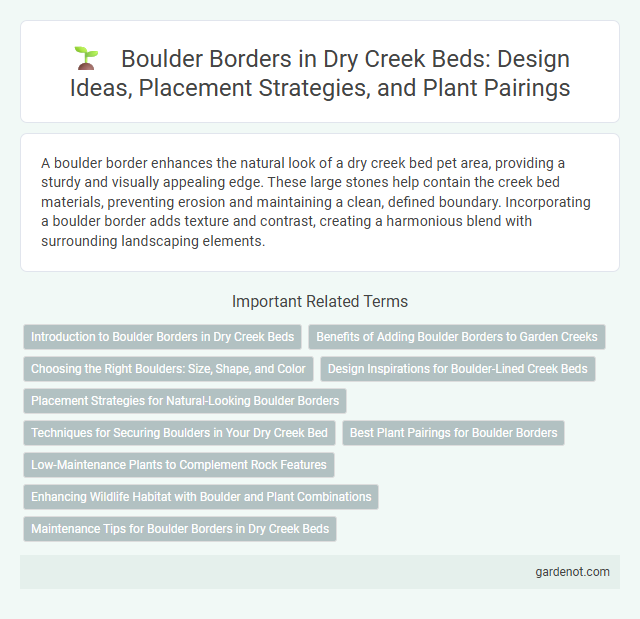A boulder border enhances the natural look of a dry creek bed pet area, providing a sturdy and visually appealing edge. These large stones help contain the creek bed materials, preventing erosion and maintaining a clean, defined boundary. Incorporating a boulder border adds texture and contrast, creating a harmonious blend with surrounding landscaping elements.
Introduction to Boulder Borders in Dry Creek Beds
Boulder borders in dry creek beds serve as essential structural elements, providing erosion control and enhancing water flow management by stabilizing soil along the channel edges. These borders are composed of carefully selected, durable rocks that create natural barriers, guiding runoff while allowing permeability to support vegetation growth. Incorporating boulder borders improves the ecological balance of dry creek beds by promoting sediment retention and reducing downstream flooding risks.
Benefits of Adding Boulder Borders to Garden Creeks
Boulder borders in garden creeks enhance erosion control by stabilizing the soil and directing water flow effectively. They create natural habitats for local wildlife, promoting biodiversity within the garden ecosystem. The aesthetic appeal of a well-placed boulder border adds structure and texture, elevating the garden's overall landscape design.
Choosing the Right Boulders: Size, Shape, and Color
Selecting the right boulders for a dry creek bed along the border involves considering size, shape, and color to ensure natural integration and aesthetic appeal. Large, irregularly shaped boulders create a realistic appearance and provide structural stability, while smoother, rounded stones offer contrast and visual interest. Choosing colors that mimic local geological formations, such as grays, tans, and earth tones, helps blend the dry creek bed seamlessly into the surrounding landscape.
Design Inspirations for Boulder-Lined Creek Beds
Boulder-lined creek beds create naturalistic landscapes that enhance water flow control and erosion prevention, drawing inspiration from rugged mountainous terrains. The strategic placement of varying-sized boulders guides stream paths while providing ecological benefits, mimicking natural sediment patterns found along the Rocky Mountain foothills. Design elements prioritize stability and aesthetic harmony, integrating native plants and textured stones to evoke an authentic, sustainable creek edge.
Placement Strategies for Natural-Looking Boulder Borders
Placing boulders strategically along a dry creek bed enhances drainage and mimics natural water flow patterns, creating authentic landscape aesthetics. Grouping boulders of varying sizes with irregular spacing prevents uniformity and promotes organic integration into the terrain. Positioning larger rocks at bends and slopes stabilizes soil while smaller stones fill gaps, reinforcing erosion control effectively.
Techniques for Securing Boulders in Your Dry Creek Bed
Techniques for securing boulders in your dry creek bed include digging shallow trenches to partially embed the base of each boulder, providing stability against shifting soil and water flow. Utilizing landscape adhesive or mortar at contact points between adjacent boulders enhances their cohesion and prevents displacement during heavy rain or erosion. Placing smaller rocks or gravel around the boulders further anchors them and facilitates natural drainage within the dry creek bed design.
Best Plant Pairings for Boulder Borders
Native grasses like Blue Grama and Little Bluestem thrive in Boulder borders, providing texture and drought tolerance alongside native wildflowers such as Blanketflower and Purple Coneflower, which offer vibrant, pollinator-friendly blooms. Succulents like Sedum and Stonecrop complement rocky Boulder borders, requiring minimal water while adding contrasting shapes and colors. Incorporating Yucca or Agave enhances the landscape with architectural interest and resilience, ideal for dry creek beds and Boulder-based xeriscaping.
Low-Maintenance Plants to Complement Rock Features
Low-maintenance plants such as succulents, ornamental grasses, and drought-tolerant groundcovers thrive along the Boulder border of a dry creek bed. These plants require minimal watering and upkeep, complementing the natural rock features while preventing soil erosion. Incorporating native species like creeping thyme and sedum enhances durability and sustainability in dry landscapes.
Enhancing Wildlife Habitat with Boulder and Plant Combinations
Incorporating strategically placed boulders along dry creek beds creates microhabitats that promote biodiversity by providing shelter and moisture retention for various wildlife species. Combining native plant species such as sedges, rushes, and willows with boulder arrangements supports pollinators, small mammals, and amphibians while stabilizing soil and reducing erosion. This habitat-enhancement approach fosters ecosystem resilience by mimicking natural riparian environments essential for sustaining local flora and fauna.
Maintenance Tips for Boulder Borders in Dry Creek Beds
Regularly inspect boulder borders in dry creek beds to prevent soil erosion and maintain structural integrity by repositioning displaced rocks promptly. Clear debris and sediment buildup around boulders to ensure proper water flow and reduce the risk of blockages that could cause overflow or damage. Use weather-resistant sealants on porous boulders to enhance durability against freeze-thaw cycles and extend the lifespan of the dry creek border system.
Boulder border Infographic

 gardenot.com
gardenot.com